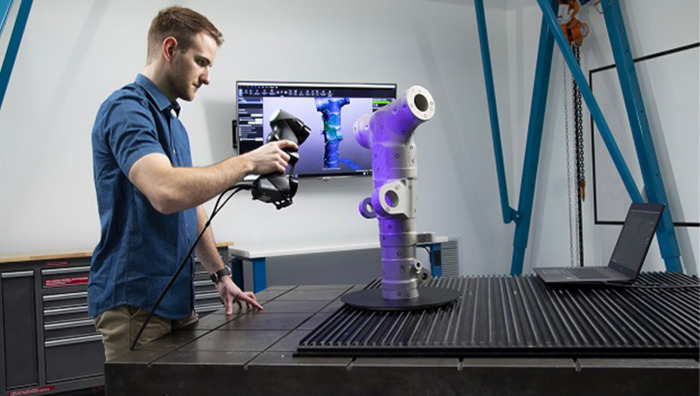In today’s rapidly evolving industrial landscape, the utilization of cutting-edge technologies has become imperative for staying ahead of the competition.
One such technology making significant strides is 3D scanning. The ability to create precise digital representations of real-world objects has revolutionized various industries, from manufacturing to research and development.
Understanding the Basics of 3D Scanning
3D scanning is the process of analyzing a real-world object or environment to collect data on its shape and appearance. This data is used to create a 3D model, which can be manipulated and analyzed digitally. 3D scanners capture the physical geometry of objects using techniques such as laser scanning or structured light.
There are various types of 3D scanners available, each utilizing different technologies for data capture. Laser scanners are popular for their ability to capture detailed information quickly and accurately, while structured light 3D scanners use projected light patterns to create a 3D model.
The applications of 3D scanning technology are vast and diverse. From product design and development to quality control and reverse engineering, 3D scanning plays a crucial role in streamlining processes and improving efficiency across industries.
Utilizing 3D Scanners in Industrial Processes
Reverse engineering involves analyzing the design of a product to understand its functionality and structure. 3D scanners are invaluable in this process as they enable engineers to create accurate digital models of physical objects for further analysis and modification.
Quality control is essential in ensuring the reliability and consistency of products. By utilizing 3D scanning technology, manufacturers can closely inspect and measure components to identify defects and deviations from the original design, thus enhancing product quality.
In research and development (R&D), innovation is key to driving progress. 3D laser scanning provides researchers with the ability to capture detailed information about objects and environments, facilitating experimentation and prototyping.
The Role of Laser Scanners in 3D Scanning
Laser scanners offer numerous benefits in 3D scanning applications, including high precision, fast scanning speeds, and the ability to capture intricate details with ease. These advantages make laser scanners an ideal choice for a wide range of industries.
Virtual scanning refers to the process of creating a digital replica of a physical object using laser technology. This virtual model can be manipulated and analyzed digitally, allowing for simulations and adjustments before physical production takes place.
Precision is crucial in industries where accuracy is paramount. Laser scanners excel in capturing data with high levels of accuracy, ensuring that 3D models and printed parts meet stringent quality standards.
Advancements in 3D Scanning Technologies
The future of 3D scanning is bright, with ongoing advancements in scanning technologies and printing methods. As additive manufacturing continues to expand, the demand for accurate 3D scan data is expected to grow steadily.
The market for 3D scanning technologies is experiencing rapid growth, driven by the increasing adoption of scanning systems across industries. With the development of more user-friendly software and hardware, the accessibility of 3D scanning has never been greater.
Probe technology plays a vital role in obtaining precise scan data for 3D modeling and analysis. By incorporating probes into scanning processes, engineers can ensure the completeness and accuracy of collected data, leading to more reliable results.
Exploring the Metrological Aspect of 3D Scanning
Metrology is the science of measurement, and when it comes to 3D scanning, metrology plays a crucial role in ensuring accurate and precise measurements. 3D scanning technology allows for the capture of detailed geometric data of physical objects, which can then be used for a variety of applications, such as quality control, reverse engineering, prototyping, and more.
One of the key aspects of metrology in 3D scanning is the calibration of the scanning equipment. Calibration involves adjusting the parameters of the scanner to ensure accurate and consistent measurement results.
This includes factors such as the resolution of the scanner, the accuracy of the scanning process, and the alignment of the scanned data.
Another important aspect of metrology in 3D scanning is the validation of the scanned data. This involves comparing the scanned data to a known reference, such as a CAD model or a physical object, to verify the accuracy of the scan.
This validation process helps to ensure that the scanned data is reliable and can be used with confidence in subsequent processes.
In addition to calibration and validation, metrology in 3D scanning also involves the analysis of the scanned data. This includes extracting measurements and dimensions from the scanned data, as well as analyzing features and surfaces for deviations or defects.
Metrology software tools are often used to process and analyze the scanned data, helping to extract meaningful information and insights from the 3D scan.
Overall, metrology plays a critical role in the field of 3D scanning, helping to ensure that the scanned data is accurate, reliable, and can be used effectively for a variety of applications.
By incorporating metrological principles and practices into 3D scanning processes, manufacturers, engineers, and researchers can benefit from the detailed and precise geometric data that 3D scanning technology can provide.
How to optimize 3D scanning for metrological applications
Optimizing 3D scanning for metrological applications involves calibrating scanners, validating results, and maintaining traceability throughout the scanning process. By following standardized procedures, organizations can achieve consistent and trustworthy measurement data.
Challenges and solutions in metrology for 3D scanning
Despite its benefits, metrology in 3D scanning poses challenges such as data interpretation and calibration errors. Addressing these challenges requires implementing robust quality control measures and utilizing advanced software tools to ensure the reliability of measurement data.


